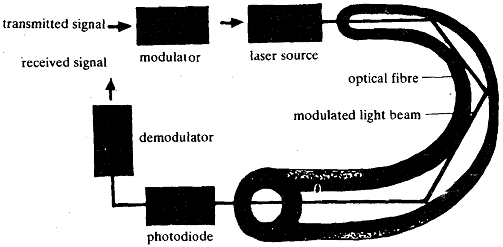Applications of Optical Fibres:
Fibre optics finds many applications in areas like medicine and communications which we will briefly describe. We will also discuss its advhtage over tradifional technologies. Viewing inaccessible regions Instruments made of optical fibres, called endoscopes, are used to see the internal organs of the human body, such as the interior of the stomach, or the bronchial tubes. Inserted into the body, some fibres of the bundle carry light so that the internal organ is lit up. Other fibres are used to return light so that the image of the interior is canied to the observer outside.
Endoscopes are often connected to a camera or TV monitor. Since these fibres are very fine, they can be irrAerted easily in the body. The images are very useful in heart and brain surgery and ia diagnosis of some other diseases. Freeing crowded cableways The use of aptical fibres has been very adkantageous in telecommunications. Signals of voice, text, computer data or picture transmissions are superimposed on laser beams. The , modulated laser beams are then guided along optical fibres, to various points where they are received. At the receiving end, one is able to hear the voice, read the data or see the picture (Fig). The signal carrying capacity of light waves is much greater than that of radio waves or waves along copper wires. Therefore, the light waves travelling in fibres can carry thousands of different signals. For instance, a pair of glass fibres can carry 1300 telephone calls at the same time, as against 24 for copper wires.

The use of laser beams in optical fibres enables the transmission of signals for thousands of kilometres. Transatlantic undersea fibre-optic cables have been in use for ~ommunication between USA and UK. Instead of being broadczst from antennas, TV programrnek can now be transmitted through fibre-optic cables.
The cable TV can, thus, make available several channels to the viewer. Freliminary experiments on the use of fibre-optic technology in India are being done so that we can also take adtantage of this technology in the coming years. Indian research laboratories have already developed the technology of producing the special glass, drawing fibres from it and giving it a special coating so that internal reflection takes place with a minimum toss. Indian industry is now manufacturing optical fibres. The fibre optics technology has many advantages over the traditional technology. An optical fibre cable, the size of an ordinary electrical cord, can replace copper cable hundreds of times thicker. Optical fibres are light and sturdy. They are much less expensive than copper wes for the amouvt of information they carry. Because optical fibres carry light beams, they are free from the disturbances. wch as you hear on the radio due to nearby electric disturbances. Fibre-optic communication is also advanrapeous for military communication because it cannot be "jammed"